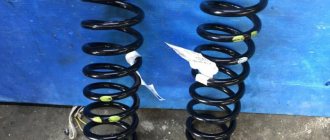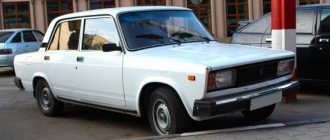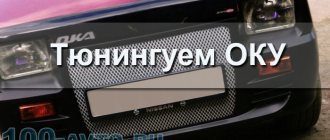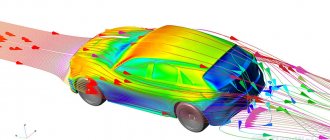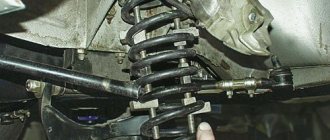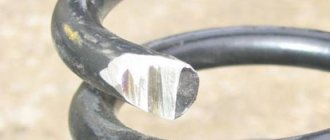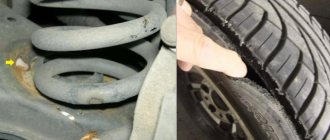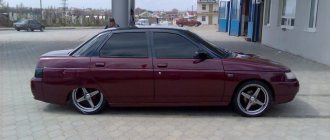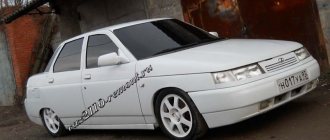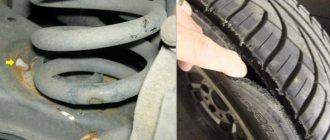Hello, dear readers! You probably know that springs play a huge role in the suspension system of any vehicle and perform several functions. If you choose them correctly, the car will be easier to drive, its load capacity will increase, you will be able to comfortably overcome road irregularities, etc. At the same time, many are confused by the marks on the springs.
Not everyone understands what these traces of paint mean, what they are like and why they differ from each other in color.
Someone will confidently say that in this way the manufacturer classifies the springs by stiffness and the color largely reflects the characteristics of the product. And they will be absolutely right.
I propose to understand in detail what these color markings are, why they are colored and how they differ from each other. If you have anything to add, be sure to write in the comments. Perhaps I will miss some important points.
Types of springs
The most common are 4 categories of car springs.
They are most often installed on vehicles. At the same time, the products are somewhat different from each other, having certain characteristics and advantages. There are 4 categories of auto springs:
Standard. This is a basic or standard version, which is mainly installed on passenger cars from the factory. Most modern models adapted to normal operating conditions are suitable; Reinforced. Help improve vehicle performance
An up-to-date solution for those for whom it is important to obtain additional strength and stability on the rear and front suspension elements for off-road driving, transporting a heavy trailer or cargo in the car itself; Raising. Or overpriced
Their installation makes it possible to increase the ground clearance, that is, ground clearance, and also improve the load capacity; Lowering. They are also called underestimators. An option for fans of sports driving. They serve to specifically reduce ground clearance and shift the center of gravity of the car.
All categories of springs are in demand and widespread in sale and use. Which ones are right for you, proceed from the operating conditions and the tasks you set for your machine.
Replacing springs may be necessary on almost any car. It's more a matter of wear and tear. If you are not going to change the operating conditions, standard products are replaced with exactly the same ones.
The procedure for replacing springs is carried out on different cars, including:
- Volkswagen Golf;
- Chevrolet Lanos;
- Renault Traffic;
- Peugeot 308;
- BMW X5;
- Skoda Octavia;
- VAZ 2110;
- VAG cars;
- Audi A8;
- Audi 100;
- Toyota Avensis;
- Mercedes ML;
- Lada Priora, etc.
The make and model do not make a fundamental difference here, since the springs can fail on any car.
But when purchasing new products, the specific brand, model, generation and a number of additional parameters must be taken into account. This allows you to select the parts that match your vehicle as accurately as possible.
What you need to know about turning in the direction of an arrow and how to avoid getting fined
In addition to color, an important indicator of an autospring is the diameter of the structure. It is determined not by the manufacturer himself, but by the car company that designs the car model. The executor of orders for the release of springs cannot independently make any changes. All parameters are calculated and verified in advance. This will allow the car to further meet the automaker’s promises in terms of comfort, safety, ground clearance and other indicators to which springs are directly related.
The abundance of flowers should not confuse motorists. This is especially true for owners of VAZ products. In this case, class A includes white, yellow, orange and brown marks. If the mark is black, blue or cyan, then it is class B.
I briefly explained the essence of the marks. The values of the marks in kilograms and millimeters during compression and stretching, as well as their combinations for different cars may differ from each other. Here you need to specifically look at the specifications for your car. Unfortunately, you can’t tell about all the cars in one article. But in general it should be clear.
Stiffness in physics notation
In the Homework section to the question what letter denotes a spring in physics, asked by the author, the European best answer is No designation spring, stiffness -K
Hello! Here is a selection of topics with answers to your question: what letter denotes a spring in physics
Reply from Dupe I know that spring stiffness is denoted by “k”, and spring...
Answer from YOUGOOOOY hardness coefficient - k
Reply from Igor Kazanzhi to
Elasticity coefficient on Wikipedia Look at the Wikipedia article about Elasticity coefficient
List of notation in physics on Wikipedia Check out the Wikipedia article about List of notation in physics
List of characters from the television series "Arrow" on Wikipedia Check out the Wikipedia article about List of characters from the television series "Arrow"
The suspension springs of any vehicle perform many important functions. Properly selected, they have a qualitative impact on the entire process of driving a car and its load-carrying capacity, make uneven road surfaces less noticeable to the driver, and increase comfort during trips, especially long ones.
Do-it-yourself car blanket: is it safe, what to make it from
The production of springs for cars involves various technologically complex operations. Not all of them can be controlled. Some of them are even impossible to follow directly until the result is obtained in the form of a finished spring for a vehicle suspension. It is because of this that mass manufacturers of car springs carry out mandatory product testing and comparative analysis. This is not just a wish of the manufacturer, but an emerging necessity.
Thus, a classification by color arose. This is one of the few ways to distinguish elements of different stiffness indicators after their manufacture has been completed. Yes, there are alternative methods, but color is considered the most simple, reliable and informative.
Symptoms of a problem
Which springs are better to install on VAZ 2114 and 2115 in case of malfunction. First you need to decide in what cases this is required. The most common reason for replacement is breakdowns. The malfunction can be identified by the following signs:
- The machine is skewed in any direction. Often the cause is broken turns;
Upon inspection, mechanical damage is visible; The car rocks, and quite sharply.
In case of any such problem, it is necessary to promptly replace the part. If this is not done, you will have problems driving the car. Also, do not forget to change the springs in pairs. When installing new springs from another manufacturer, it is recommended to do this in a circle.
Most often, drivers do not bother with the selection of parts and simply buy ordinary stock spare parts. Overall, this is a good option. They last quite a long time and cost little. But there is one caveat here. The original springs are quite soft, which makes the car not very stable when cornering. This doesn't suit speed lovers too much. Also, original parts don't handle a full vehicle load very well.
In this case, they sag. If you often carry large groups or the trunk is constantly loaded, then it is better to choose something more rigid.
When to change?
Let me refer to quotes from the forums: look at how your lower control arm is relative to the ground, measure the distance from the edge of the wheel to the arch, and the like. Of course, there is some truth in all this, BUT these are all consequences. We need to look at the reason, that is, at the spring itself. The next legitimate question is: where to look? The photo shows springs from the same car, one side before replacing the springs, the other after.
when to change springs?
Why is color coding required?
The mark placed on the product will help the motorist select a modification that meets his needs. If you install springs of different stiffnesses on a car, the body will not be parallel to the road. In addition to the unaesthetic appearance, this is fraught with instability during driving - one part of the car will be depreciated in a mode different from the other side of the vehicle.
The same applies to the height of the products. In this case, of course, the size of the parts is often compared. To speed up the process of sorting products, manufacturers apply a color mark to all products that corresponds to specific technical characteristics.
What happens if you install too stiff springs?
If the springs
too hard, the ride quality will suffer.
The performance of tires on bumpy, uneven surfaces
will be sacrificed for rigidity Also, overly stiff springs
contribute to oversteer. In other words, if it is too stiff, the handling will become worse than it was before.
Interesting materials:
How does a nuclear reactor work? How does Wi-Fi work? How is the cable car constructed? How are globular clusters arranged? How to insulate a glass thermos? How to recycle car tires? How to dispose of a sold car without documents? How to dispose of expired medications? How to recycle tires in St. Petersburg? How to enlarge a Wifi antenna?
Correspondence of spring markings to the model
Let's look at what springs need to be used in specific models of the VAZ automaker:
- Springs 2101 are intended only for “penny”;
- A more rigid modification is marked 21012. They are made from thicker rods, which makes the products stronger than the previous analogue. They are installed on classics, which require a more energy-intensive suspension;
- Springs with symbols 2102 are intended for station wagons models 2102 and 21014. Compared to previous modifications, these parts are two centimeters longer. They can be installed on a sedan, but only if the car is used in rural areas. Such springs slightly increase the vehicle's ground clearance. However, they cannot be installed to enable the vehicle to carry heavier loads than those intended by the manufacturer. Otherwise, the body will have to be repaired very soon.
- The designation 2108 is given to parts intended for front-wheel drive VAZ cars. The exception is Oka and models with a 16-valve engine. It is worth considering that these same springs are also intended for 21099. There are no separate springs for this model, so the seller’s offer to purchase “originals” for the 99th is nothing more than an attempt to sell standard parts at a higher cost.
- Elements from European manufacturers marked 2110 are intended for models starting with 21102 and ending with 21104, as well as for VAZ-2112 and 2114. The European version makes the car 2 centimeters lower, but makes it more controllable at high speeds. You should not use such parts on vehicles that often travel on dirt roads and rough terrain.
- Modifications 2111 are intended for rear suspensions of models with identical markings, as well as VAZ-2113.
- Springs from category 2112 are intended for the front part of the suspension of the following models: 21113, 21103 and 2112.
- All-wheel drive vehicles of the VAZ family are equipped with 2121 springs.
Main varieties
Before we begin to consider the types of springs for cars, let’s briefly remember why they are needed. When moving over uneven surfaces, the car should remain soft. Otherwise, the trip will be no different from traveling by cart. To ensure comfort, automakers equip vehicles with suspension.
In fact, comfort when using the suspension is an added bonus. The primary purpose of springs in a car is transport safety. When a wheel hits an obstacle at speed, such as a bump, the shock absorber softens the impact. However, to prevent the car from losing traction with the road surface, the wheel must be quickly returned to a hard surface.
More details about why a car needs springs are described in this video:
What are car springs used for?
Springs are needed for this purpose. But if only they are used in vehicles, even a small bump at speed will cause the car to sway violently, which will also lead to loss of traction. For this reason, springs in modern vehicles are used in conjunction with shock absorbers.
The classification of all springs for cars is as follows:
- Standard. Such an automobile element is installed by the manufacturer when assembling the model on the conveyor. This variety corresponds to the technical characteristics specified in the technical documentation of the machine.
- Strengthened version. These springs are stiffer than the factory counterpart. This type is perfect for vehicles used in rural areas, since the springs in this case will experience more load. Also, such modifications are equipped with cars that often transport cargo and tow a trailer.
- Increasing spring. In addition to increased ground clearance, such springs increase the vehicle's load-carrying capacity.
- Lowering springs. This type is usually used by sports driving enthusiasts. A lowered car has a center of gravity closer to the road, which increases aerodynamics.
Despite the fact that each modification has its own differences, they are all manufactured using special technology.
Interesting
Very often, class A and B markings are also called hardness markings. Indeed, if you need to regularly travel with a full load, then it is better to use class A, as they can withstand a slightly larger load. However, this difference is small and amounts to approximately 25 kg.
Manufacturers do not always apply markings in accordance with the requirements of current standards. However, the color marking of the spring, assigning it to a certain class, must be applied. Moreover, it must be the same on both springs purchased, matching each other in color. If there is no such color marking, then it is better to refrain from purchasing them.
I like2I don't like
What do the colored marks on springs mean: how to understand the markings
Hello, dear readers! You probably know that springs play a huge role in the suspension system of any vehicle and perform several functions. If you choose them correctly, the car will be easier to drive, its load capacity will increase, you will be able to comfortably overcome road irregularities, etc. At the same time, many are confused by the marks on the springs.
Not everyone understands what these traces of paint mean, what they are like and why they differ from each other in color.
Someone will confidently say that in this way the manufacturer classifies the springs by stiffness and the color largely reflects the characteristics of the product. And they will be absolutely right.
I propose to understand in detail what these color markings are, why they are colored and how they differ from each other. If you have anything to add, be sure to write in the comments. Perhaps I will miss some important points.
Spring materials
Springs are made from special carbon and alloy steels, as well as from special non-ferrous alloys. The starting materials for the manufacture of springs are wire, tape, rods, and strip. For the manufacture of twisted springs, the use of high-carbon spring wire with a diameter of up to 8 mm (GOST 9389-75) is very common.
The spring material, after appropriate heat treatment, must have elastic properties that are stable over time, significant strength and high resistance to impact loads
In addition, sometimes when choosing a spring material, it is necessary to take into account its electrical conductivity, coefficient of thermal expansion and other specific conditions under which the spring must operate. In instrument making, springs made of steel and other metals are used, for example, phosphorus and beryllium bronze, nickel silver, brass, etc.
etc. Depending on the design, manufacturing method and operating conditions, springs can be made from solid heat-treated or annealed material with subsequent heat treatment.
The characteristics of spring materials are given in the table:
Properties of spring materials
| Name of material and brand | Characteristics and application of the material |
| I-class wire | High tensile strength and large residual stresses after drawing and coiling. |
| Wire classes II and IIA | It differs from class I wire in reduced tensile strength and increased ductility. Used for springs operating at low temperatures, as well as for extension springs with complex hook designs. Class IIA wire differs from class II wire in higher dimensional accuracy |
| Manganese steel 65G | Fatigue strength is normal. After heat treatment, it has spring properties and high strength, poorly resists impact loads, and has an increased tendency to form hardening cracks. Suitable for any type of spring. Operating temperature limit from -40 to +120° C |
| Chromium-adium steel 60HFA | Increased heat resistance (up to 400° C). It heats up to a hardness of no more than HRC 52. It takes shock loads very poorly, can work without coatings in an atmosphere of normal humidity, has high elastic and viscous properties, and is the best material for class I springs |
| Silicon steel 60S2A | High fatigue limit, withstands sharp impact loads very well, has high elastic and viscous properties, is prone to decarburization when heated, can work without coating in an environment of normal humidity. Resistant up to temperatures of 250°C. Used for springs of classes I and II |
| Silicon steel 70SZA | After heat treatment, it has high elastic and springing properties with sufficient ductility, and is prone to decarbonization of the surface layer |
| Beryllium bronze Br. B2 | Has fatigue strength; Designed specifically for operation in magnetic fields and aggressive environments at normal temperatures and without sudden shocks. Suitable for any type of spring |
| Silicon-manganese bronze Br. KMtsZ-1 | Has fatigue strength; Designed specifically for operation in magnetic fields and aggressive environments at normal temperatures without shock. Suitable for any type of spring |
For springs made from strip steel in accordance with GOST 2614-65, steel grades U8A, U10A, U12A, 65G are used, and for especially critical springs, steel grades 60S2A and 70SZA are used. For conductive springs or springs operating in a magnetic field, you can use wire made of silicon-manganese bronze Br.KMtsZ-1 and for especially critical springs bronze Br-B2.
All about springs for Lada 4×4 5D. Buying springs Lesjöfors / Kilen
Maybe this information will be useful to someone, I searched through catalogues, was interested in DRIVE2.ru.
So, 3 types of springs were installed on the Lada 4×4 5D, depending on the year of manufacture: 1. Springs from Nadezhda: Front 2120-2902712 (rod diameter 16mm, free length 273mm, stiffness 89.56 kgf/cm) Rear 2120-2912712 (diameter rod 14.2 mm, free length 405 mm, hardness 30.96 kgf/cm)
2. Springs from Niva 2121: Front 2121-2902712 (bar diameter 15.2 mm, free length 278 mm, stiffness 74.42 kgf/cm) Rear 2121-2912712 (bar diameter 13 mm, free length 434 mm, stiffness 22.44 kgf/cm)
3. For cars produced since 2010, the so-called emki: Front: 21214-2902712-00 (bar diameter 15.2 mm, free length 289 mm) Rear: 21210-2912712-00 (bar diameter 13 mm, free length 434 mm, hardness 22, 44kgf/cm)
Popular foreign analogue: Front: Lesjöfors 4047006/Kilen 15033 (for long wheelbase) (bar diameter 15mm, free length 288mm, stiffness 75.8 kgf/cm) Rear: Lesjöfors 4247002/Kilen 15033 (bar diameter 13mm, free length 4 41mm, hardness 22 ,3kgf/cm)
There are also rear reinforced ones: Lesjöfors 4247010/Kilen 55037, (rod diameter 13.75 mm, length 415 mm, stiffness 29.7 kgf/cm).
Also on the Lada 4×4 5D springs from the VAZ 2123 are installed: Front: 2123-2902712 (bar diameter 15.7 mm, free length 313 mm, stiffness 75 kgf/cm) Rear: 2123-2912712 (bar diameter 13.9 mm, free length 410 mm, hardness 30kgf/cm)
Having measured the thickness of the rod on the rear springs, I determined that I have springs from a short Niva (2121-2912712), the diameter of the rod is 13 mm (accordingly, the length will be 434 mm), for comparison, on springs from Nadezhda (2120-2912712) the diameter of the rod is 14.3 mm ( length 405mm). I didn’t want to take domestic ones, since according to reviews they sag quickly, so I opted for rear springs Lesjöfors 42 470 02 (bar diameter 13mm, length 441mm).
Source
Spring classes “A”, “B” and “C”, which ones are better
Suspension springs not only improve handling quality, but also ensure a smooth ride on uneven roads. In addition to their useful qualities, they have a number of characteristics; their compliance with the requirements of the car is extremely necessary. Data such as length, thickness, shape or even the material of pendants play an important role, and neglecting the choice will lead to dire consequences.
Let's look at the classes of suspensions. It is generally accepted that the more expensive the components of the mechanism, the better. And this topic could be discussed for a long time if the matter did not concern springs, which, like cars, are divided into three categories “A”, “B” and “C”.
The first class includes products of world famous brands. These are premium elements from companies such as Sachs, Kayaba or Bilstein. When you look at these brands, you can see that their reliability matches your budget. An ordinary driver cannot count on affordable prices. However, these companies provide full guarantees of longevity and strength.
Subtype “B” is responsible for cheaper suspensions that are accessible to the average consumer. Do not rush to be upset if you cannot afford the elite among manufacturers, because middle class parts are of acceptable quality.
And finally, cheap “C” class goods, which cannot be characterized by high quality, are nevertheless the most affordable for the entire segment of motorists. What's the trick and why is it so budget-friendly? The fact is that companies selling springs in this category massively purchase ready-made suspension elements from a Chinese manufacturer.
How to choose the right part? We dealt with different classes, made certain conclusions, but how do you still choose chassis springs for your car? Among the large assortment, choose exactly those designs that most closely resemble the original ones. You need to choose a product with an ideal seat and original outer diameter. In this case, the number of turns in the spring and its length are not particularly important
Please note that color markers and bar diameter measurements differ from one manufacturer to another, so when choosing, focus on the manufacturer, the type of mechanism and its rigidity. Choosing the wrong product may impair vehicle stability and damage the body and shock absorbers.
Bottom line. If you have several parts of different classes, remember that the best springs must be installed on the front axle. It is impossible to assemble and combine parts on both sides of one axis, and if one of a pair of products fails, both should be replaced. Always listen to the advice of the manufacturer of your car; no one else recommends a more correct approach in choosing a chassis. Incorrectly selected springs will change the ground clearance and shake the angles of the wheel configuration, which is why all other elements of the vehicle will wear out extremely quickly.
Ax against roundness. Test drive Jeep Wrangler Sahara
See all photo news >>
Characteristics of suspension springs for VAZ cars
You can find out the price of a part by the catalog number (article), which is indicated in the tables.
1 Before coating. 2 Dimensions and parameters for reference. 3 Including control washers. 4 DP - existing production; PP - production preparation; ZCh - spare parts; OV - extended turn; n.d. - no data.
Features that the best springs for a VAZ should have
Many people wonder what rear springs to put on a VAZ 2114?
There are several points that the owner of domestic transport should pay attention to:
- Spring diameter. Affects the level of suspension stiffness.
- Number of turns - the more there are, the lower the rigidity.
Choosing suspension springs
People who require a good level of steering control like to install rigid rear products. True, in this situation, adhesion to road surfaces decreases. That is, any option has its advantages and disadvantages. But all the same, you can always choose the appropriate type for any Russian model.
Determination of the stiffness coefficient
The stiffness coefficient (it is also called the coefficient of elasticity or proportionality) is most often written with the letter k, but sometimes you can find the designation D or c. Numerically, the stiffness will be equal to the magnitude of the force that stretches the spring per unit length (in the case of SI - 1 meter). The formula for finding the elasticity coefficient is derived from a special case of Hooke’s law:
The greater the stiffness value, the greater will be the resistance of the body to its deformation. Hooke's coefficient also shows how resistant a body is to external loads. This parameter depends on geometric parameters (wire diameter, number of turns and winding diameter on the wire axis) and on the material from which it is made.
The SI unit of stiffness is N/m.
Installation Tips
Do not forget that the springs on the suspension must be installed of the same class. For example, people installed A-class parts on the front suspension, it turns out that class “A” also needs to be installed on the rear suspension. If there are no products of the same class for the rear suspension, then, as an exception, class “B” is installed on the rear part.
If the front suspension has B-class springs, then it is prohibited to install “A” class springs on the rear suspension. Place suspensions of the same class on the left and right sides of the same axle.
Replacing springs VAZ 2114
So, the choice of springs for VAZ is very wide
The most important thing is to choose the right stiffness characteristics that will suit the vehicle load and conditions of use. You can find all sorts of advice on the Internet.
Of course, it is better to first consult with a specialist. Refusal of original components in favor of other manufacturers may be dictated by the idea of improving the running parameters of the vehicle, but be sure to compare the price of tuning and the result obtained.
How to use springs according to their class
The car suspension must be equipped with springs that are of the same stiffness class. Many parts have yellow or green markers applied to them. In the first case, it will be a soft element, and in the second, a standard or more rigid one for difficult operating conditions.
